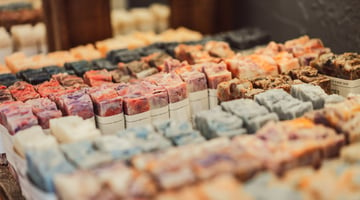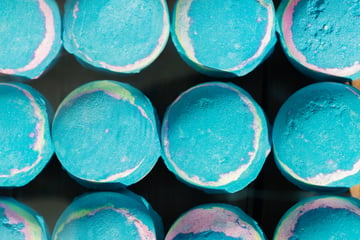 Crafting of all kinds has become much more accessible to the modern consumer thanks to specialty and online retailers as well as an abundance of educational content, classes, and workshops. While the barrier to entry for many craft niches is relatively low, some makers have developed a passion for more complex, involved, and even slightly dangerous crafts. While it may not be the first hobby of this type to come to mind, the art of modern soapmaking had grown exponentially over the past several years thanks to its online tutorials and shifting attitudes toward beauty and skincare.
Crafting of all kinds has become much more accessible to the modern consumer thanks to specialty and online retailers as well as an abundance of educational content, classes, and workshops. While the barrier to entry for many craft niches is relatively low, some makers have developed a passion for more complex, involved, and even slightly dangerous crafts. While it may not be the first hobby of this type to come to mind, the art of modern soapmaking had grown exponentially over the past several years thanks to its online tutorials and shifting attitudes toward beauty and skincare.
While soapmaking can be an intense craft that requires a lot of research, practice, and even a knowledge of science, it's also one of the fastest-growing craft categories in the Maker Movement today. In this post, we'll share some of the most important demographics and statistics that help define who today's soapmakers are as well as list some of the most popular soapmaking trends of 2019.
Soapmaking Statistics and Demographics
 Soapmakers today use one or more soapmaking methods to create their own scented soap in both bars and molded shapes. With just a base supply list consisting of scented oil, lye, and water, soapmakers use both specialized soap equipment and common kitchen tools to mix and pour their own custom creations or to recreate recipes from a tutorial. The "dangerous" part of soapmaking stems from the chemical reactions that result in the final soap product, but as long as makers know how to use their ingredients and work with goggles and gloves, there's very little actual risk in making soap.
Soapmakers today use one or more soapmaking methods to create their own scented soap in both bars and molded shapes. With just a base supply list consisting of scented oil, lye, and water, soapmakers use both specialized soap equipment and common kitchen tools to mix and pour their own custom creations or to recreate recipes from a tutorial. The "dangerous" part of soapmaking stems from the chemical reactions that result in the final soap product, but as long as makers know how to use their ingredients and work with goggles and gloves, there's very little actual risk in making soap.
By both the uptick in soap-related content and the listing pages of Etsy, we know that soapmaking is on the rise as one of the hottest crafts on the market. But who are today's soapmakers, and how do they get started with the hobby? Here are the statistics and demographics you need to know:
- There are over 76,000 Etsy listings for "handmade soap."
- According to the Handcrafted Soap & Cosmetic Guild, there are about 300,000 soap-making businesses in the U.S.
- 95% of soapmakers are women.
- Handmade bars of soap typically sell for $6-$8 on average, though prices vary widely across the market based on ingredients, design, and other factors.
- Startup costs for a soapmaking hobby or business can vary as well. While a simple operation can be started at home for around $50-$150 in supplies, those numbers can jump to $300-$500 if you factor in soapmaking classes, bulk supplies, packaging and more.
Soapmaking Trends
The beauty of soapmaking is that independent makers get to control every ingredient that goes into their soaps, from the scents to the colors and everything in between. While some are most concerned with creating a simpler, cleaner soap that you can buy at the drugstore, others are more fascinated by the beautiful colors and scents they can create and mix together for aesthetic purposes. Either way, there are a number of popular soapmaking trends that we're seeing across the board when it comes to handmade soaps today.
 Intricate designs: Some of the best-selling handmade soaps today are the ones that take the most care and practice to create — the bars with impossibly intricate, swirling or geometric designs. While some makers favor an organic top edge to give their bars character, others focus more on the internal design that's consistent through the entire bar. Thanks to online tutorials and creative experimentation, we're seeing some of the most impressive soap designs on the market today.
Intricate designs: Some of the best-selling handmade soaps today are the ones that take the most care and practice to create — the bars with impossibly intricate, swirling or geometric designs. While some makers favor an organic top edge to give their bars character, others focus more on the internal design that's consistent through the entire bar. Thanks to online tutorials and creative experimentation, we're seeing some of the most impressive soap designs on the market today.- Essential oils: While most soaps incorporate some kind of scented oil as part of the experience, some soapmakers choose to add specific essential oils to their soaps because they believe that these scents can provide certain health benefits to their users. While at the end of the day, a nice smelling soap is always going to be popular, the use of essential oils intended to improve moods or boost energy are common in the craft.
- Crystals: In a similar sense, crystals are popular among certain audiences today thanks to both their potential healing powers as well as their general look and aesthetic. Molding soaps into crystal shapes is one of the most popular trends today for makers who are into sculpting their soaps.
- Organics/Eco-friendly: One of the main reasons that many makers start to create their own soaps is because of their concerns surrounding the ingredients and sustainability associated with mass-produced soaps and bath products. In order to create alternative options, soapmakers are often drawn to organic and eco-friendly ingredients when sourcing their raw materials. Many soapmakers believe that using these ingredients make their products healthier, more responsible, and in many cases, more likely to sell in the competitive soapmaking market.
 Bath bombs: True, bath bombs require a completely different process and, to some degree, different ingredients to make than soaps, but in the handmade bath products industry, customers are asking for bath bombs, and makes are finding ways to deliver. Considering today's culture of self-care, luxurious bath products like bath bombs are in high demand, and soapmakers are jumping on the bandwagon to offer their own versions of these fizzy bath time treats.
Bath bombs: True, bath bombs require a completely different process and, to some degree, different ingredients to make than soaps, but in the handmade bath products industry, customers are asking for bath bombs, and makes are finding ways to deliver. Considering today's culture of self-care, luxurious bath products like bath bombs are in high demand, and soapmakers are jumping on the bandwagon to offer their own versions of these fizzy bath time treats.
The Art and Chemistry of Soapmaking
What many soapmaking beginners are surprised to discover is that soapmaking is as much as science as it is an art. It's incredibly important for soapmakers, both new and experienced, to fully understand the chemistry behind soapmaking and how their recipes and ingredients affect the final soap products they're producing. Because of this dual-nature of soapmaking, the craft can be incredibly labor-intensive. On average, it takes cold processed soap four to six weeks to fully harden and cure, not to mention the hours of prep and mixing it takes to create a batch of bars. However, for makers with a lot of patience, a knack for experimenting, and a love of rewarding hard work, making their own soap is the perfect craft segment to get involved in.



